Sandy
Volunteers gather mounds of trash from seemingly "clean" Alki
Jun/16/14 07:58 AM
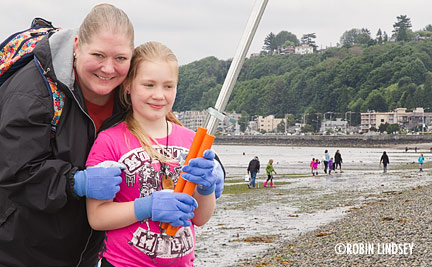
SS Lead Investigator Robin Lindsey and Amy Webster, PAWS Community Education Coordinator, gave a brief talk about the dangers of marine debris to wildlife. Since Friday was a dreary, rainy day with few beach-goers and Parks had done its usual early morning trash pickup, Alki Beach looked deceivingly void of trash. However, 73 volunteers (60 adults and 13 kids) fanned out over a wide area stretching from Constellation Park to Duwamish Head and sidewalks above, armed with gloves and long tweezers to pluck trash (photo shows PAWS Wildlife Rehabilitation Manager Emily Meredith with her daughter, as participants scour the beach in the background).
As volunteers returned to drop off their bags and buckets of trash, the pile grew by leaps and bounds - testimony that what appears to be a small amount of litter, indeed is very substantial. Among the inventory of intact and broken bottles, beer and soft drink cans, more than a thousand cigarette butts (which leech harmful chemicals into the water), plastic bottles, caps and lids was a dope pipe, a very disturbing 6 hypodermic needles (found in differing locations), a sizable blanket (large enough to potentially kill a gray whale if swallowed), auto tire, part of a boat, chains, piece
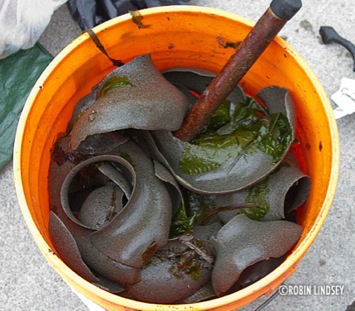
A number of volunteers also enthusiastically brought us what they thought to be plastic or rubber trash, but which were moon snail collars (photo right) - thin, circular casings of sand and mucous, each of which contains about 300,000 eggs. The collars were promptly returned to the beach. For information about moon snail collars, read Seal Sitters’ education advisor Buzz Shaw’s marine life blogpost.
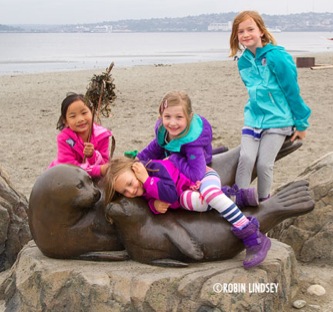
Seal Sitters thanks Seattle Parks for providing materials for the cleanup and our co-sponsor/partners PAWS Wildlife Center and Alki Community Council. We hope everyone will continue to pick up trash during their trips to the beaches - every day is beach cleanup day.
"Sentinels of the Sound" beach cleanup June 14th
Jun/10/14 07:01 AM
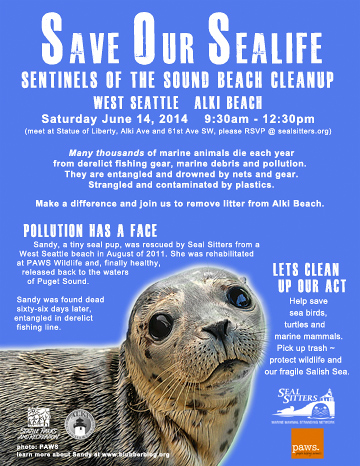
Please RSVP.
Prior to dispersing volunteers with materials to pick up trash, Seal Sitters and PAWS Wildlife Center will speak briefly at 9:30 about the dangers of marine debris to wildlife and the difficult rehab of harbor seal pups.
All marine life is endangered by marine debris and pollution. Many, many thousands of marine animals and sea birds die each year from derelict fishing gear, marine debris and pollution. They are entangled and drowned by nets and gear. Strangled and contaminated by plastics. Sea birds choke on plastic and limbs are severed.
This year's beach cleanup events will once again be in honor of seal pup Sandy who was rescued from a West Seattle beach in August of 2011, rehabilitated at PAWS Wildlife Center, and then released back to the wild in January of 2012. Sandy was found dead 66 days later, entangled in derelict fishing gear. The event is also in honor of the juvenile gray whale that died on Arroyos beach in April of 2010. The necropsy revealed only human trash in the whale’s stomach.
Please join us to help save marine life! For more info and to RSVP, please click here.
No "butts" about it - Alki Beach cleanup a success
Aug/03/13 09:04 PM
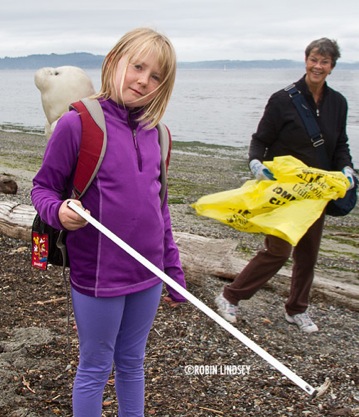
Because yesterday was such a dreary, rainy day with not too many beach-goers, there was not the typical overflow of Friday night garbage strewn all over the sidewalks and beach. However, we assured everyone they would find lots of small, harmful trash - including many cigarette butts. In fact, well over an estimated thousand cigarette butts were picked up in a matter of hours along with plastics and paper.
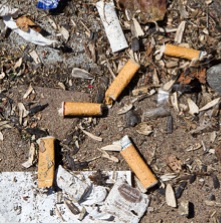
The beach cleanup was a great success - all in all, over 100 hours of volunteer time were donated this morning (we’re still tallying the hours) to help keep all of us and the wildlife we love safe. We thank everyone for their hard work and passion! And a special thanks to SS hotline guru Larry Carpenter for puling everything together to make this happen.
"Sentinels of the Sound" beach cleanup in honor of seal pup Sandy
Jul/17/13 07:07 PM
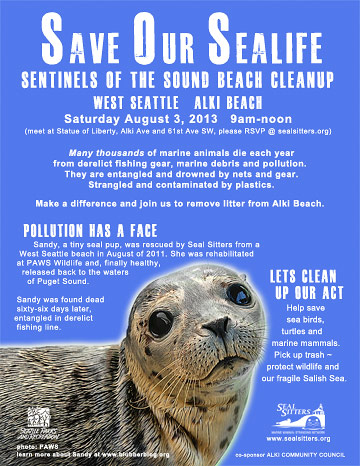
Harbor seals (who do not migrate and are year-round residents) and orcas, both animals at the top of the food chain, are especially hard hit by pollutants from storm runoff and microplastics which are stored in their blubber. A 2005 study showed that harbor seals of South Puget Sound were 7 times more contaminated with PCBs than those of Canada's Georgia Strait. The orcas of Puget Sound are the most contaminated marine mammals in the world.
All marine life is endangered by marine debris and pollution. Many, many thousands of marine animals and sea birds die each year from derelict fishing gear, marine debris and pollution. They are entangled and drowned by nets and gear. Strangled and contaminated by plastics.
This year's beach cleanup events will once again be in honor of seal pup Sandy who was rescued from a West Seattle beach in August of 2011, rehabilitated at PAWS Wildlife Center, and then released back to the wild in January of 2012. Sandy was fitted with a satellite tag (glued to her fur which would be shed when she molted) to monitor her success in the wild and provide valuable data to biologists about foraging patterns of rehabbed seals. Sixty-six days later, Sandy was found dead, entangled in derlict fishing line off the Edmonds Pier. Read more about Sandy.
Sandy has truly put a face on pollution. Trash on the beach becomes treacherous in the water. You can make a difference! Help keep our beaches clean and our sea life safe. Read more about marine pollution here.
We would also like to honor the memory of the Arroyos gray whale who stranded and died in 2010. The necropsy revealed that there was no food in the thin juvenile male's stomach - only human trash.
Seal Sitters, along with co-sponsors Alki Community Council and Seattle Department of Parks and Recreation, will hold a cleanup of West Seattle's Alki Beach on Saturday, August 3 from 9am-noon. We will assemble at Alki's Statue of Liberty plaza (61st Ave SW and Alki Ave SW). Please RSVP for this event so we have enough bags and equipment on hand.
Read about last year's event here.
New study reveals seal pups learn foraging skills at early age
Dec/19/12 10:17 AM
SeaDoc Society has just released the findings of a study of 20 satellite tagged weaned harbor seal pups, half of whom were tagged in the wild and half after rehabilitation. The study shows that rehabbed pups travel greater distances than wild pups foraging for food. Read this fascinating story here.
West Seattle stranded seal pup Sandy was satellite tagged and released in late January this year after a lengthy rehab at PAWS. Hundreds of people logged onto SeaDoc’s site and followed her progress and travels around Puget Sound until she was found dead in April, entangled in derelict fishing gear. Her death put a face on the dangers of marine debris and pollution and a beach cleanup was held in her honor. Read about Sandy here.
West Seattle stranded seal pup Sandy was satellite tagged and released in late January this year after a lengthy rehab at PAWS. Hundreds of people logged onto SeaDoc’s site and followed her progress and travels around Puget Sound until she was found dead in April, entangled in derelict fishing gear. Her death put a face on the dangers of marine debris and pollution and a beach cleanup was held in her honor. Read about Sandy here.
Honeysuckle the rehabbed pup's surprising travels
Sep/08/12 07:16 AM
Honeysuckle was an abandoned harbor seal pup rescued by the Whatcom Marine Mammal Stranding Network on Lummi Island and rehabbed at Wolf Hollow on San Juan Island. SeaDoc Society fitted her with a satellite tag before her release so that her movements could be tracked and provide data to researchers. Her travels surprised everyone. Watch the video here. You can follow Honeysuckle’s travels on SeaDoc Society’s dedicated webpage.
Seal Sitters’ seal pup Sandy was also fitted with a satellite tag early this year. Her story did not have such a happy ending and she was found dead, entangled in derelict fishing line off the Edmonds pier. Read Sandy’s story here.
Seal Sitters’ seal pup Sandy was also fitted with a satellite tag early this year. Her story did not have such a happy ending and she was found dead, entangled in derelict fishing line off the Edmonds pier. Read Sandy’s story here.
Beach cleanup a big success as volunteers honor seal pup Sandy
Jul/22/12 11:19 AM
While the beach did not appear to be as littered as usual on a summer Saturday morning due to a rather rainy Friday, the volunteers filled about 10 large trash bags. They picked up many cans, plastic bottles and caps, countless cigarette butts, and among other things a kayak paddle, a woman's black and pink bra and dirty diapers. Students from UW's Environmental Studies program each donated over 3 hours of their time, picking up bags of trash including spent fireworks on Constellation Beach - fireworks that leave toxic residue and contaminate the Sound. We even had a family drive all the way from Ellensburg, well over 100 miles each way, just to pick up trash on the beach! Brooklyn, the "almost" 9 year old daughter, read about seals on our website, saw the post about Sandy and told her mom and dad (super-parents Vanessa and Kevin) that she wanted to come help seal pups by cleaning up the beach. We can't thank everyone enough for helping out. A total of 128.5 hours were donated yesterday morning. All of these volunteers are a true inspiration and made a difference for our sea life. Special kudos to SS vols David and Eilene Hutchinson and Larry Carpenter.
Find out more about the dangers of marine pollution on Seal Sitters’ website.
Alki Beach cleanup in honor of seal pup Sandy
Jul/09/12 05:44 AM
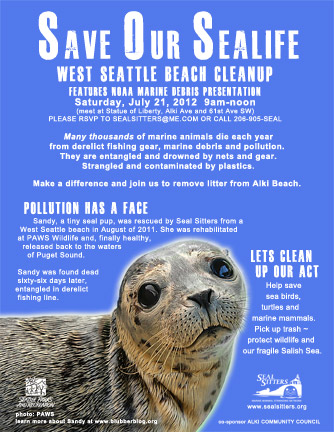
Sandy the seal pup truly puts a face on the dangers of marine pollution and trash. You may also remember the young gray whale that stranded and died on Arroyos Beach - the only contents in his stomach were human trash. Please make a difference and join us. Countless thousands of marine animals die as a result of marine debris, trash and pollution. Trash that is on the beach becomes treacherous in the sea. Read more about marine pollution on Seal Sitters’ website.
Peggy Foreman of NOAA will discuss the dangers of marine debris and pollution shortly after we assemble at 9am. We will meet at the Statue of Liberty (next to the Alki Bathhouse on Alki Beach 61st Ave SW and Alki Avenue SW). Please rsvp for this event as Parks will be providing trash grabbers and buckets for participants.
To print out a copy of this flyer to post at your work or business, please click here. The flyer is a full bleed and may need to be set at “reduce to fit” for some inkjet printers.
Divers recover seal pup Sandy's body for necropsy
Apr/05/12 09:49 PM
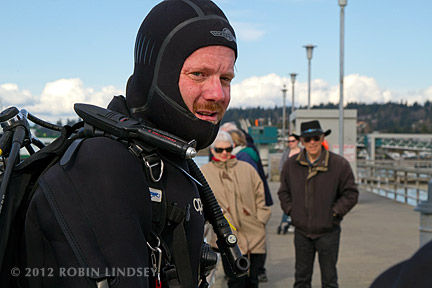
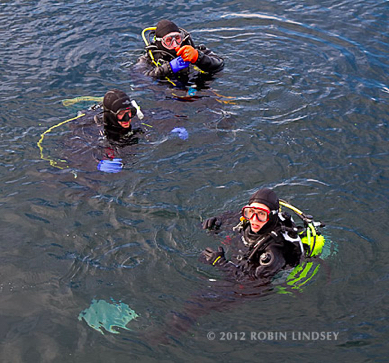
Yesterday, while the MaST team searched the cold waters below (photo right), Seal Sitters’ lead investigator was stationed up on the pier to keep them safe from fishermen’s casts. She had an enlightening conversation with lone fisherman Nick about derelict lines and lures. According to Nick, there are a number of large tires that have been sunk off the pier in order to create habitat for fish. While fish have indeed become abundant in this habitat, the problem is that lures are constantly getting caught on the rubber tires and fishermen can’t reel them back in. Much to the frustration of the fishermen, the lines then have to be cut, leaving a maze of ebbing monofilament, hooks and lures which put marine mammals and sea birds at great risk. Nick said that Des Moines had sunk tires as well years ago, but finally removed them all. It was his and other fishermen’s opinion that Edmonds should follow suit. When the MaST team completed the dive, Sandy in tow, the divers mentioned the amazing amount and variety of large game fish in the habitat - and where there are big fish, there are usually the small bait fish that seal pups prefer.
While the Edmonds pier situation appears irreparable without removal of the tire habitat, Seal Sitters has noticed that the fishing piers in West Seattle (Water Taxi and Duwamish Head piers) are often strewn with cut line and hooks. There are a number of sea gulls seen by the piers with only one leg - the direct result of having line sever a leg. Volunteers David and Eilene recently removed line from the leg of a gull. Lincoln Park’s favorite fishing hole by Colman Pool is littered with line and hooks everywhere when the fish are running. We respectfully ask that fishermen please be more careful and not leave derelict gear. Not only are seal pups and gulls endangered - so are people and other animals.
Huge thanks to MaST’s stranding team Rus, Kaddee and Arthur for recovering “satellite” Sandy, whose movements were followed by almost 600 residents of Puget Sound via her SeaDoc Society dedicated web page. The satellite revealed that Sandy travelled 990 kilometers (615 miles) in the 66 days she swam free in the wild. The death of Sandy has truly put a face on the dangers of marine debris and derelict fishing gear. Seal Sitters intends to dedicate our annual beach cleanups in her memory. We hope you will join us.
Derelict fishing gear dangers - and what to do
Apr/03/12 01:37 PM
The death of seal pup Sandy, who drowned entangled in fishing line, has raised many questions the past two days. People have been asking what to do about derelict fishing gear should they come upon it. First of all, derelict gear, especially line and nets, is extremely dangerous. Never get close enough to risk becoming entangled yourself. Northwest Straits Derelict Gear Removal Program has informed us that a diver became entangled and died during a fishing line recovery operation several years ago.
If by sad chance, you see a dead marine mammal entangled in gear, get a photo if possible. If the animal is tagged and you can do it safely, try to get a photo of the tag number. Do not put yourself in danger to do so. Do not attempt to remove the animal or the fishing gear. Email the photo of the animal to Kristin Wilkinson, NOAA’s NW Marine Mammal Stranding Expert, along with lat/long information. To report only derelict gear, please contact NW Straits - they are the experts at removal.
What should you do if you encounter a live entangled animal? First, if at all possible, call the NOAA stranding network @ 800-853-1964 (in the West Seattle area call 206-905-7325). Keep in mind that most of the networks do not have boats or divers readily available for that type of response except in matters of whales. We want to stress the inherent danger in trying to free an animal. If you insist on proceeding at your own risk in this highly dangerous task, NOAA’s Good Samaritan clause will protect you from Federal prosecution for the “take” of a marine mammal (Marine Mammal Protection Act). The Good Samaritan exemption is as follows (found on NOAA website):
It shall not be a violation of this chapter to take a marine mammal if:
1) such taking is imminently necessary to avoid serious injury, additional injury, or death to a marine mammal entangled in fishing gear or debris
2) reasonable care is taken to ensure the safe release of the marine mammal, taking into consideration the equipment, expertise and conditions at hand
3) reasonable care is exercised to prevent any further injury to the marine mammal and
4) such taking is reported within 48 hours
Please note: This MMPA exemption does not protect you from liability of monetary damages from the owner of the net or fishing gear.
We cannot say enough how tremendously dangerous fishing gear is to all living things - including you. The last thing we want is a human tragedy on top of this environmental one.
If by sad chance, you see a dead marine mammal entangled in gear, get a photo if possible. If the animal is tagged and you can do it safely, try to get a photo of the tag number. Do not put yourself in danger to do so. Do not attempt to remove the animal or the fishing gear. Email the photo of the animal to Kristin Wilkinson, NOAA’s NW Marine Mammal Stranding Expert, along with lat/long information. To report only derelict gear, please contact NW Straits - they are the experts at removal.
What should you do if you encounter a live entangled animal? First, if at all possible, call the NOAA stranding network @ 800-853-1964 (in the West Seattle area call 206-905-7325). Keep in mind that most of the networks do not have boats or divers readily available for that type of response except in matters of whales. We want to stress the inherent danger in trying to free an animal. If you insist on proceeding at your own risk in this highly dangerous task, NOAA’s Good Samaritan clause will protect you from Federal prosecution for the “take” of a marine mammal (Marine Mammal Protection Act). The Good Samaritan exemption is as follows (found on NOAA website):
It shall not be a violation of this chapter to take a marine mammal if:
1) such taking is imminently necessary to avoid serious injury, additional injury, or death to a marine mammal entangled in fishing gear or debris
2) reasonable care is taken to ensure the safe release of the marine mammal, taking into consideration the equipment, expertise and conditions at hand
3) reasonable care is exercised to prevent any further injury to the marine mammal and
4) such taking is reported within 48 hours
Please note: This MMPA exemption does not protect you from liability of monetary damages from the owner of the net or fishing gear.
We cannot say enough how tremendously dangerous fishing gear is to all living things - including you. The last thing we want is a human tragedy on top of this environmental one.
Seal pup Sandy drowns in fishing gear
Apr/01/12 07:52 PM
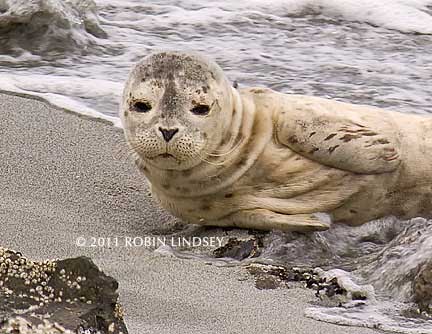
Sandy was only three weeks old, weighing 7.1 kgs (a third of normal body weight for a nursing pup), when she was rescued by Seal Sitters from a West Seattle beach on August 15, 2011 (photo right). She spent a lengthy 5 month rehab at PAWS, but was a robust pup when finally released at a harbor seal rookery in South Puget Sound. Through the combined efforts of PAWS, NOAA, SeaDoc Society and WDFW Marine Mammal Investigations, Sandy was fitted with the satellite tag in order to provide valuable data to researchers. The satellite revealed she stayed relatively close to the release point for the first few days, but then she began taking off on adventures - south to Olympia, north to the San Juans, circling Vashon, back to Olympia and Shelton, up to Edmonds a couple of times. After being in a small pool for so many months, it seemed as though she had the travel bug and appeared to be thriving in the wild (map below shows her travels). The last satellite hit was on the 27th.
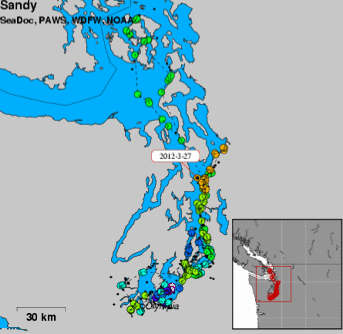
Sandy is not the only harbor seal with a West Seattle connection to die from fishing gear. A few days before we rescued her last August, we responded to a dead adult female on Beach Drive. The necropsy showed that the female had given birth within ten days or so and the cause of death was from fishing line and lure, twisting the female’s stomach and causing an agonizing death. A newborn pup we nicknamed Tiny died on another beach the same day as the necropsy. It is not beyond the realm of speculation that Tiny was this female’s pup and that fishing gear caused the death of both animals.
This is truly a very sad day. Special thanks to PAWS’ staff who nursed Sandy back to health and cared for her for so many months. For those of us who participated in her release, we will never forget the joy of seeing her swimming free in the Sound with that little yellow-green satellite hat. SS volunteers and Puget Sound residents signed up to receive SeaDoc Society email alerts and excitedly followed her movements online. To read more about Sandy and view the video of her release back to the wild, click here.
To learn more about the dangers of marine debris and how you can help, click here.
NOTE TO DIVERS:
If you are a diver and come upon animals who have died in derelict gear, we ask two things. First, please take a photograph and email a jpg to us. We will forward the photos to the appropriate person for a corresponding database - this will greatly help assess the true number of animals that perish each year. Secondly, please indicate the location of the derelict gear if you have lat/long finder and we will report it to the Northwest Straits Derelict Fishing Gear Removal Program which estimates that 50,000 animals are entangled and die each year in Washington waters just in shallow water nets and gear (excluding an unknown number in deep-water derelict gear). Harbor seals had by far the highest number of deaths among marine mammals in gear they removed. According to their website :
As of November 30, 2011, the Northwest Straits Initiative has removed 4,081 derelict fishing nets and 2,668 crab pots from Puget Sound, restoring 596 acres of critical marine habitat. Over 241,700 animals, representing more than 240 species, were found entangled in this gear.
Please spread this message among your diving community and make a difference for the marine mammals of Washington. Do not attempt to remove fishing gear - it is extremely dangerous. NW Straits has informed us that a diver drowned in Puget Sound a few years ago on a sport fishing line cleanup.
Satellite Sandy cruising the San Juan Islands
Mar/11/12 09:54 AM
The seal pup that Seal Sitters MMSN rescued from the beach in August is now cruising the San Juans. We know this because after a lengthy rehab at PAWS Wildlife Center, Sandy was fitted with a satellite tag and released at a harbor seal haul out south of Tacoma. She has been moving all over the region - Olympia, Shelton, Vashon Island, 3 Tree Point, West Seattle, Richmond Beach and now the northern islands. You can follow Sandy’s lengthy travels on SeaDoc Society’s dedicated webpage and receive email alerts when a satellite picks up her signal. Her movements enable biologists to learn more about seal pup behavior. The glued-on tag will fall off when Sandy sheds her fur coat in a few months.
PUPDATE 3/12
The latest satellite hits show that Sandy has opted to head back south and was pinged at the northeast tip of the Olympic Peninsula. This is a bit of a relief since we wonder if she is able to tell the difference between the vocalizations of the transient orcas who eat seals and that of the residents who prefer salmon. With no mom to have taught her the ins and outs of life in the wild, she is trying to figure things out on her on.
PUPDATE 3/12
The latest satellite hits show that Sandy has opted to head back south and was pinged at the northeast tip of the Olympic Peninsula. This is a bit of a relief since we wonder if she is able to tell the difference between the vocalizations of the transient orcas who eat seals and that of the residents who prefer salmon. With no mom to have taught her the ins and outs of life in the wild, she is trying to figure things out on her on.
Seal pups galore in West Seattle
Mar/08/12 07:58 AM
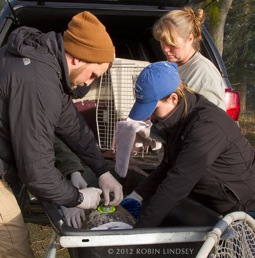
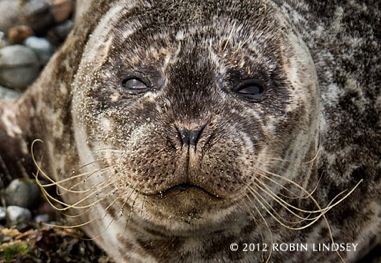
Sandy the satellite-tagged pup near Vashon Island
Feb/21/12 06:47 AM
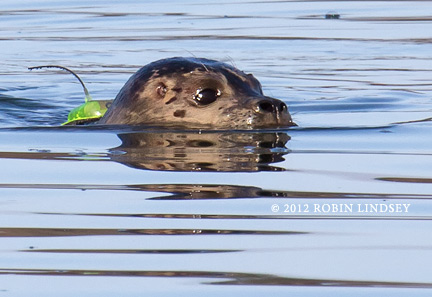
Keep your eyes peeled for a little seal pup with a yellow transmitter on her back. If you see her, please keep your distance and call our hotline @ 206-905-7325 (SEAL). Her movements are being studied by biologists and will give tremendous insight into the behavior of rehabilitated pups as they try to adapt to life back in the wild. SeaDoc has a web page devoted to Sandy here and you can receive email updates as to her locations and cheer her on. It is very exciting for volunteers and the public to be able to follow Sandy’s progress and see how well she is doing back in the Salish Sea.
Satellite Sandy spreads her wings in the Salish Sea
Feb/16/12 09:47 PM
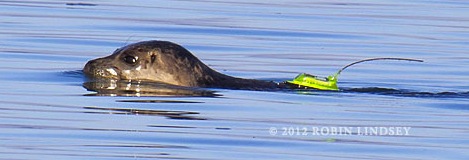
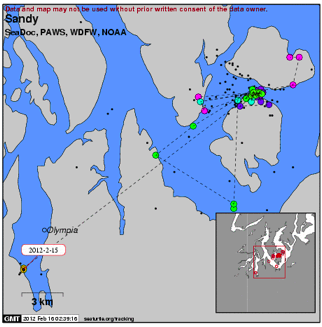
You can follow Sandy’s travels on SeaDoc’s website. In fact, you can even get an email alert when passing satellites pick up her signal. Check out Sandy’s dedicated page here. And, if you happen across a log boom, grab your binocs and see if there is a seal or two catching some zzzz’s - maybe you’ll even see Sandy with her fancy yellow hat!
Seal pup Sandy released back into the wild
Jan/31/12 05:52 PM

Sandy’s movements will provide ground-breaking information for biologists. She can be tracked by the public as well on SeaDoc Society’s website, which has a web page dedicated to her, showing a map of her cruising around South Puget Sound. In the photo above, Sandy swims in the wild with her new satellite hat. Tracking this animal would not be possible without the collaboration of several network groups which include: Seal Sitters MMSN, PAWS Wildlife Center, WDFW Marine Mammal Investigations, SeaDoc Society and NOAA’s Protected Resources Division.
PUPDATE: Feb 2/2012
We have had some folks with concerns that the satellite tag is somehow harmful for Sandy. The tag is applied with glue to Sandy’s pelt and will fall off when she sheds her fur during molting season in a few months. Most likely, the tag will fall off before then; however, in the interim, the satellite tracking will provide researchers with insights into foraging patterns, distances travelled by weaned pups and health and mortality data. This research will help other seal pups in the future.
Rehabbed pup Sandy due for release
Jan/19/12 12:26 PM
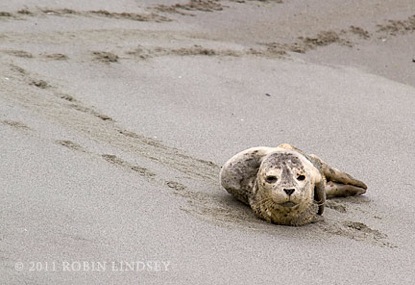
Sandy will be fitted with a satellite tag. This will provide valuable information to biologists and the hope is that the public will be able to track her movements via the internet as well. Her release had been planned for tomorrow, however, due to snow and ice conditions, it will be rescheduled. Please check back for photos of her release to a South Puget Sound haul out site and information about potential website monitoring. It would be a thrill to be able to follow Sandy’s progress back home in the sea.
Seal pup Sandy thriving in rehab at PAWS
Oct/02/11 07:56 AM
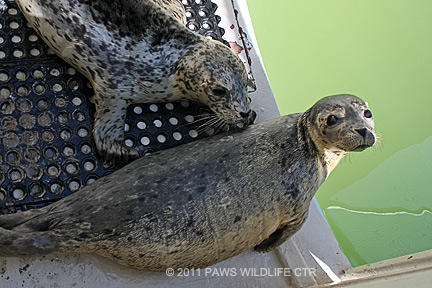
Fauntleroy ferry dock pup too weak to survive
Aug/27/11 05:39 AM
Seal Sitters and the NOAA Hotline received numerous calls late yesterday morning from concerned folks waiting to board the ferry at the Fauntleroy dock. Our responder found an extremely thin pup at the tide line and established a substantial boundary with yellow tape so that he would not be scared back into the water. We are not sure how long the pup had been at this location, but it was obvious that he was in some serious trouble. Unfortunately, it is a sad fact that every pup in need cannot be rescued from the beach and taken for treatment due to limited treatment resources - PAWS can only accommodate ten pups at a time and the rehab is quite lengthy. In dire emergencies, a pup can be flown to Wolf Hollow Wildlife Center in the San Juans courtesy of Kenmore Air. That trip, however, is extremely stressful for any wild animal who already is in a tenuous battle to live. Whenever possible, stranding network volunteers monitor an animal for 24 hours in hopes they will return to the Sound to forage for food in an effort to survive. After observing this horribly thin pup, nicknamed Qakak by neighbors, Seal Sitters intervened mid-afternoon and rescued him from suffering on this beach frequented by people with off-leash dogs - always a danger to seal pups. The pup died en route to PAWS and will be necropsied by WDFW Marine Mammal Investigations’ biologist to determine cause of death.
Thanks to the kayakers who went well out of their way to launch further up the beach. They realized that a small inconvenience to humans can often be the difference between life and death to a resting baby animal. Many kudos to those caring adults and kids.
On a brighter note, Sandy, the small pup rescued from another West Seattle beach, is doing well at PAWS and could be our first success story of this season. Early in the past two seasons, we have had terribly small pups who have struggled with no mom around. It is a tough statistic that only 50% of pups make it to their first year and nature can be pretty harsh at times - all the more reason that they need to rest. Take heart that soon, we will have some fat little pups who have been successfully weaned in the rookeries visiting our beaches!
Thanks to the kayakers who went well out of their way to launch further up the beach. They realized that a small inconvenience to humans can often be the difference between life and death to a resting baby animal. Many kudos to those caring adults and kids.
On a brighter note, Sandy, the small pup rescued from another West Seattle beach, is doing well at PAWS and could be our first success story of this season. Early in the past two seasons, we have had terribly small pups who have struggled with no mom around. It is a tough statistic that only 50% of pups make it to their first year and nature can be pretty harsh at times - all the more reason that they need to rest. Take heart that soon, we will have some fat little pups who have been successfully weaned in the rookeries visiting our beaches!
Seal pup Sandy doing well in rehab
Aug/19/11 07:20 PM
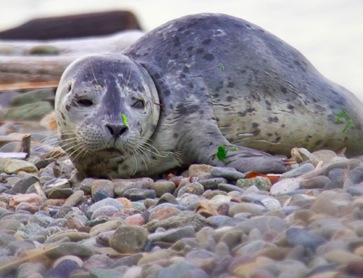
Sandy is shown here in the light of early evening on the pebbled beach north of the Water Taxi landing. A seal’s fur looks very different when wet or dry (see dry photo in story below), often making identification difficult. For this reason we try to get detailed photos of spots and markings which enables us to track an animal if there are health concerns. In Sandy’s case, she had very defined markings on her left foreflipper and around the eyes, so we were easily able to identify her when she hauled out on a different beach.
PUPDATE 8/22/11 PAWS reports that Sandy is still doing well and taking whole fish.
Small pup hauls out on sandy beach
Aug/14/11 11:21 PM
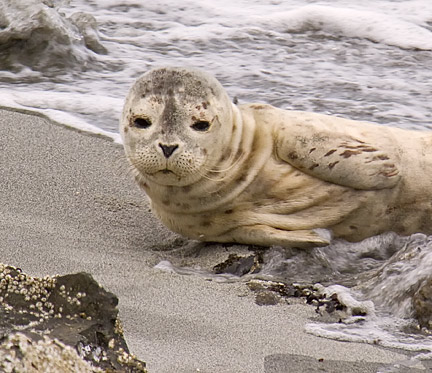
Seal Sitters would like to extend special thanks to Greg and Alki Kayak Tours for being so cooperative in sharing the cove with this very sweet and very tired little pup - and for keeping people at bay until our volunteers could arrive on scene.
PUPDATE 8/15/11 12:30 pm: Sandy, a too thin pup who apparently has no attending mom, was still on the beach at sunrise this morning and was taken to PAWS. Please check back for updates.
PUPDATE 8/15/11 4:30pm: PAWS reports that Sandy is doing well at the facility. She is a female, but weighs a mere 7.1 kg (or 15.6 lbs). That weight is a full two pounds less than our little beauty, Storm, who we rescued from Lincoln Park last year - and who was successfully rehabbed and released by PAWS ten weeks later. A healthy pup being nursed by mom should weigh between 21-23 kg. Keep Sandy in your thoughts as she will undoubtedly face some challenges.







